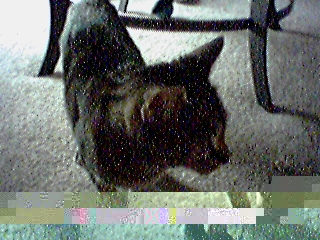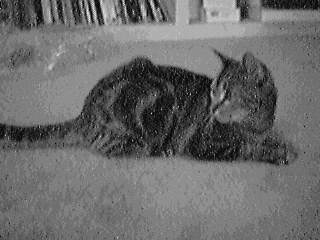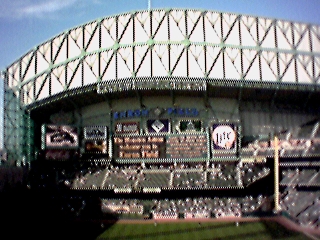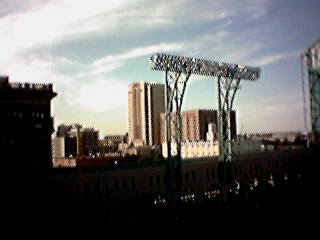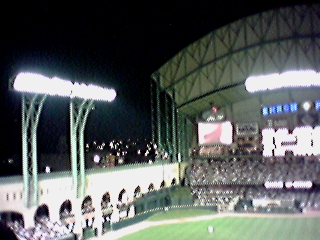 | |
| news | articles | reviews | software | modules | accessories | discussion | faq | mobile | store | |
| visorcentral >> reviews >> springboard modules >> eyemodule | |
eyemodule
Usability When you insert the eyemodule, there is an initial splash screen and then the Visor turns into a viewfinder for any photos that you take. Then When files are synced, your images become .jpg files in the default name of dd_mm_yy_hh_mm_ss_am/pm.jpg, and by default are placed in C:eyemodule
Next to the Viewer button is the Image List, where you can delete a single image or an entire category. On the Preferences screen, you can set defaults for image format, default category, and whether to backup the images that are taken. So how well do the pictures look? It depends on the situation. Because there is no flash, you will need a lot of light for decent color photo; greyscale pictures seem to do better when there isn't much light. In these photos of our kitten, Sabrina looks fine in greyscale, although the picture is a little grainy. The color photo of Sabrina has very little color in it because the lighting in our home isn't the greatest.
I wanted to get some good examples of daytime/nightime photos, so what better way than to go watch an Astros game outside at Enron Field! The daytime pictures look pretty good, although they are a little fuzzy. The text from the scoreboard is very easy to read with the naked eye but is difficult to make out in these photos. The sky, however, looks great, and the late afternoon photo shows a good range of colors as the sun begins to go down.
Nightime photos of the scoreboard were worse. The words "Enron Field" are the only lighted words that can be read in the photos. Any lights in the pictures are blurred together, making it impossible to ready any lighted text. There isn't much color differentiation, and the players look extremely tiny on the field, when they can actually be easily seen. The one thing that this eyemodule sorely lacks is a flashbulb.
Looking at these pictures, the eyemodule
may not look too hot, but that depends on your intent. If you are
planning to take professional looking photos or will be photographing in
poor lighting, the eyemodule is not for you. My favorite thing about
the eyemodule is its "coolness" factor. Every time I take it out
in public for test shots or to show a friend, it definitely draws a crowd.
When I took the photos at Enron Field, I ended up showing an usher the
camera. When I showed it to some classmates at college, the professor
was so interested in the Visor that she wrote down Handspring
and asked if it was traded publicly. I also like the small size of the
eyemodulel, especially in comparison with a normal digital camera.
It is, however, too large to be inside the Rhodiana
Visor Case or the E&B
Slipper Visor. It will however, fit in the Otter
Box 2000, the RhinoPak
1100, and the RhinoPak
2000, although you won't be able to strap it against the Visor hard
cover in the Rhino cases. The diminutive size of the eyemodule makes
it seem like the kind of camera James Bond would use, and the eyemodule
could probably be used to take secret photos if the lighting was good enough.
(I hope to one day get a chance to test this theory As for battery usage, the eyemodule does drain the Visor's batteries significantly when taking photos. The drain is not as severe as some other digital cameras, but you should always carry a spare set of batteries in the pouch that comes with the eyemodule "just in case.
|
Update: Auction Update / VisorAdventure 2 Thu Oct 11 - 12:05 AM EST InnoGear PowerCradle (updated) Tue Oct 9 - 10:51 PM EST iambic Office suite Thu Oct 4 - 1:12 AM EST Prism dropped to $299 Tue Oct 2 - 6:19 PM EST New Portable Keyboard Tue Oct 2 - 4:46 PM EST |
| About VisorCentral : Copyright ©1999 Smartphone Experts All rights reserved : Terms of Use : Privacy policy |
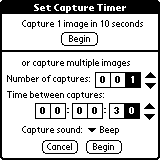 There
are a surprising number of options that comes with the eyemodule software.
You can take images in three different formats:
There
are a surprising number of options that comes with the eyemodule software.
You can take images in three different formats:
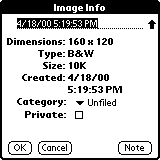 The
button to the right of the Viewfinder is to
view your images. Press the Up/Down
button to move among your photos when you have one on screen. Here
you can also zoom in on any 320x240 image, beam it to someone, and pull
up the information on the image. On the Information
screen you can change the name of the image, modify its category, add a
note, or mark it private. I really like the fact that I can beam
the eyemodule application to someone, and
then beam any pictures to that person. The eyemodule
app, along with any pictures, stays on the Visor even when the eyemodule
is not in the Springboard slot.
The
button to the right of the Viewfinder is to
view your images. Press the Up/Down
button to move among your photos when you have one on screen. Here
you can also zoom in on any 320x240 image, beam it to someone, and pull
up the information on the image. On the Information
screen you can change the name of the image, modify its category, add a
note, or mark it private. I really like the fact that I can beam
the eyemodule application to someone, and
then beam any pictures to that person. The eyemodule
app, along with any pictures, stays on the Visor even when the eyemodule
is not in the Springboard slot.
